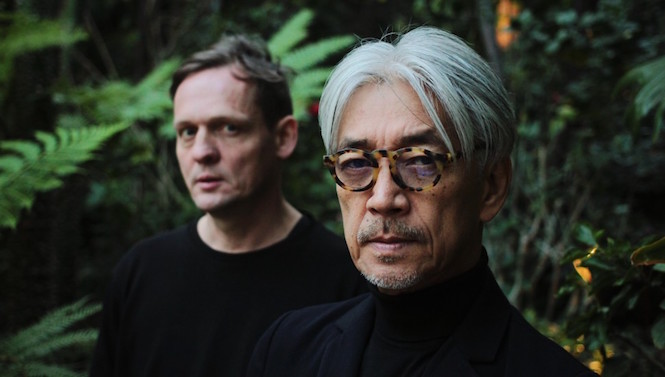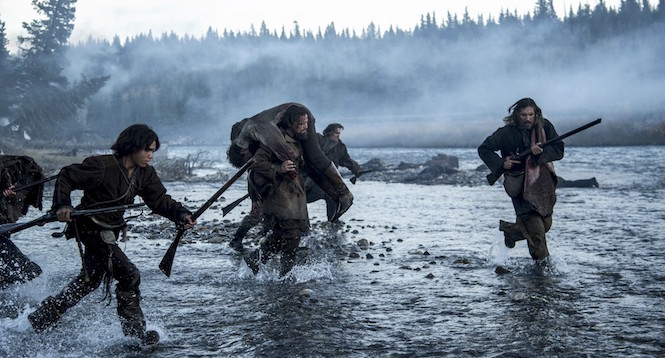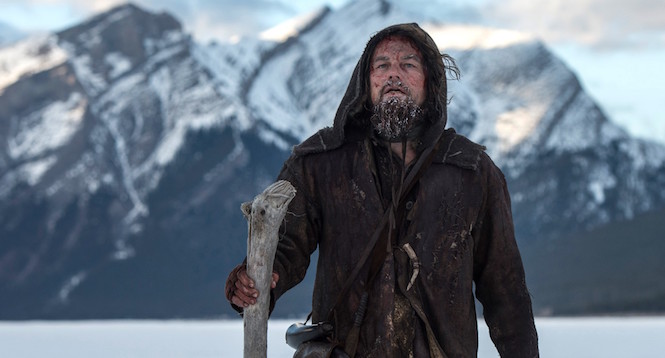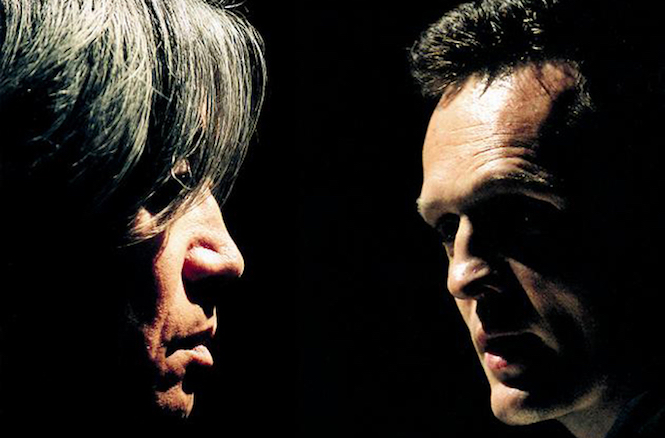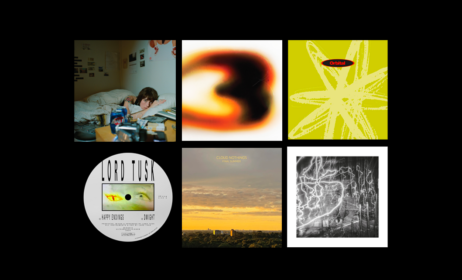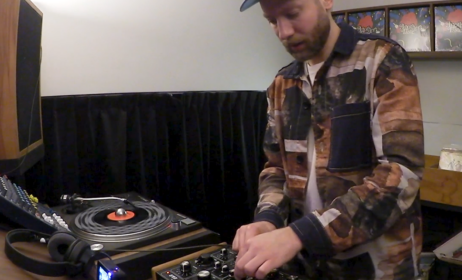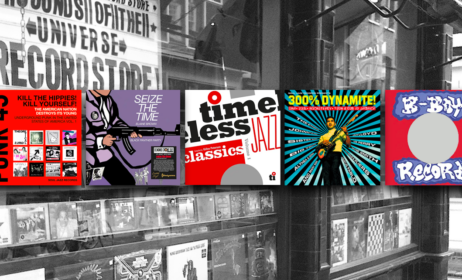Published on
February 23, 2016
Category
Features
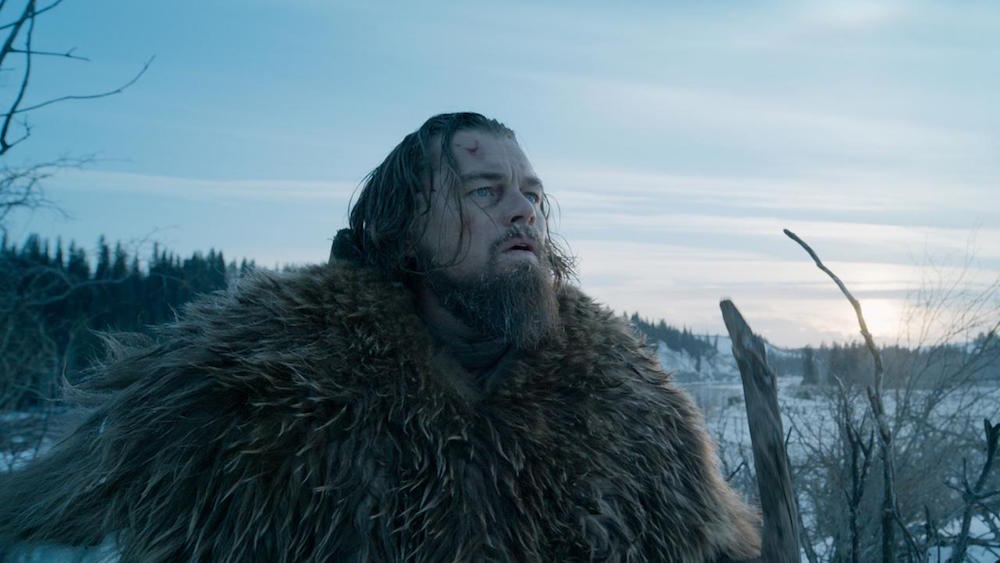
Ryuichi Sakamoto of Yellow Magic Orchestra fame and Carsten Nicolai (Alva Noto) speak to Amar Ediriwira about their score for Oscar-tipped frontier saga The Revenant.
“Ryuichi’s music soul has impregnated The Revenant and the film breathes between his notes and nature sounds and silences,” writes Mexican director Alejandro Iñárritu in the soundtrack’s liner notes. He goes on to describe Carsten Nicolai’s electronic universe as one that eludes definition and characterises The National’s Bryce Desnner as a “more crazy original and delicious guacamole than I could ever dream of”.
Led by Sakamoto, this is the super-trio behind The Revenant‘s heart-pounding score. A unique patchwork of orchestral and electronic visual sounds, their modulated cues play the voice of nature in Iñárritu’s harrowing hymn to the natural world.
Shot with signature unbroken takes, entirely in natural light in the remote wilds of sub-zero Canada, Iñárritu’s crew were put through an endurance test (almost) on par with the one faced by Leonardo Di Caprio – who might finally snatch an Oscar.
With a grand total of twelve nominations at this year’s awards, the icy and painfully visceral Western has been lauded as a sensory marvel, a hypnotic entwining of moving image and sound. Following last year’s success with the equally audio-visual Birdman, wayward auteur Iñárritu is expected to sweep up again. And yet, because Sakamoto layered his work with that of the other composers, the soundtrack is ineligible to compete as per the Academy rules.
As I said earlier in the year, fuck the rules. It might have been released in January but this is set to be score of the year (yes, even better than Ennio’s return to the genre); the shared credit should be celebrated, not rejected.
To that end, I caught up with long-time collaborators Ryuichi Sakamoto and Carsten Nicolai (Alva Noto) to learn about how the soundtrack was made.
Photograph: Jasper Berbaum
Ryuichi, the project started with you – with Carsten and then also Bryce later called upon. When did Iñárritu initially get in touch?
Ryuichi Sakamoto: It was in May of last year that my manager received a call from Alejandro’s office saying “Come to LA as soon as possible.” I’ve known and enjoyed Alejandro’s films for years, so naturally I took the opportunity to work with him.
Later in the process Alejandro kept asking for more electronic textures and treatments. The workload was already enormous as I was scoring another Japanese film simultaneously. Since Alejandro was already using some of Carsten’s works in the temp music, we both agreed bringing him in to help.
Carsten Nicolai: Yes, some of my previously released music had already been brought into the score, as well as some existing work from Ryuichi and my previous collaborations. These acted mostly as placeholders before I officially joined. So I felt very welcome when I began collaborating because the rough edits had already the sound aesthetics that I share.
It’s a massive and incredibly rich score. I’m curious about how your contributions played out in practice?
CN: Many cues are all composed by each of us individually and layered. Many other cues were collaboratively composed. Some other parts we tried to add very specific sounds. The sound editor, Martin Hernandez, played a very important role, as did Alejandro. I appreciated our shared love for every little detail – a very specific idea for sound for each scene.
RS: For the most part all the orchestral strings were composed and recorded by me, and some by Bryce although separately. Carsten worked mostly on electronic treatments of my recordings as well as his own textures and electronic manipulations.
Hildur Gudnadottir gives a terrific performance on cello, but in a way the most remarkable orchestral part belongs to Motoko Oya.
RS: While in Japan we wanted to record with an Ondes Martenot, which is a rare, ancient electric instrument; there are only maybe a handful in the world. We were lucky to find Motoko Oya, who played it beautifully.
Was there a lot of back and forth with sound editor and director before settling on the cues as we hear them in the film?
RS: I submitted tons of recordings, sketches, sounds, some synths, piano, big taiko drums, and much more. Martin Hernandez would then take all the elements and cut and place them for Alejandro to see what was working and what was not. Then we got feedback and would repeat this process. We were sometimes surprised by what was kept or rejected, but in the end it really works.
As you said in a recent interview Ryuichi, the real main character in the film is nature, which puts Leo’s character through a full-blown endurance test. The soundtrack does a great job of supporting the drama on screen without being brutal or savage itself. Was that always the intention?
RS: It was always my intention to write something that complements the stark, cold simplicity of nature. In a way nature’s brutality can be much stronger than anything created by man, man is always fighting against nature, and losing. So I wanted the music to complement nature, be an extension of the cold, hard, but incredibly beautiful images captured by Alejandro and his team.
CN: What was essential to us is that the sound could create a kind of ‘time zone’. In many moments we simply had to create the feeling that time is passing. The movie is very dynamic, brutal and beautiful. We shared the responsibility in the score to create these moments which are rooted in fundamental relations – dichotomies and intimacies, of man and nature. We are all a part of this, and from this position we could find the closeness to the movie.
The point about time is interesting given that the film was shot in natural light. It also refrains from using CGI where possible. Was there an attempt to give the music a naturalistic quality too?
CN: Yes – the images feel very natural, we are in the forest, the snow… the intense landscape. It was important for me that the electronic sound could compliment this. There is a beautiful quote from my favorite director Tarkovsky: “The boundaries between music and sound were blurred, as natural sounds and music interact to the point were they are indistinguishable. (…) Electronic music must be purged of its ‘chemical’ origins, so that as we listen we may catch in it the primary notes of the world.”
RS: I think that was a natural outcome, but not necessarily the intention. I’ve always felt truth in the saying “less is more”, and strive for that in my writing. And nature itself is like that as well. One can be deeply affected by the simplest beauty of nature, a pinecone, a warm breeze, or the relentless barrage of the sea.
Birdman won big at the Oscars last year and with The Revenant poised to follow suit, Iñárritu has garnered a huge amount of respect as a director. I imagine he had a very strong direction for each and every aspect of the film, sound included.
RS: Each director is very different, so there is a period of understanding their method of expression and building a common language. At times there were frustrations but that is inevitable when people come together to make something great. Alejandro has such a strong vision and is uniquely able to clearly express it. It was a joy to work with someone with so much passion for his work.
CN: He is an artist – such a dedicated, focused visionary. At the same time he is a very collegial and warm hearted man. I really enjoyed working as part of the larger team as well. During direct work with him, he was incredibly specific about the timing, even the pitch, the placement of one single sound. He has an incredible memory of each detail.
If he had an idea of how to improve a cue he would ask us for little exercises. At the moments we found the right sound he felt connected and very emotionally responsive to it. I remember one of these ‘exercises’ to connect three short scenes in which the task was to create the feeling of the weeks passing. It was hard, and in the end we found something that delivers that feeling in 23 seconds!
It’s a shame that the score isn’t eligible for the Oscars because of the way the contributing parts are assembled.
RS: Well every award organization has their rules, and of course none of us joined the project with any award being our pursuit. That being said, in the future I can see more great films having this issue, and since art is not a static part of culture, but flexible, changing, and interpretative, I think it would benefit the Academy to take a closer look at their rules.
Carsten, this is the first film project you’ve been involved with. What did you make of the experience?
CN: What a privilege to that it was for a work by Alejandro. I had been a big admirer of his works for years and I was actually very intrigued by the way he used sound, especially after I seen Birdman. I could see that finally someone sees the potential of sound and moving image in an absolute symbiosis.
On the one hand it was very important not to become too absorbed in the sound itself as I normally work – as if to lose the general feeling for the movie, the narrative, its own character of intensity – specifically when there are so many scenes to take care of in detail. On the other hand, since i’m working mostly on electronics I also continued to try to emphases the sound that cannot be achieved with an orchestra.
I learned so much it is hard to measure. I started understanding the process of editing a movie and how complex the post-production process is. The intense time working for this movie created a kind of trance for me – and I loved the intensity. Of course I would love to continue to score, but the way I work is very specific. Let’s see what comes.
The pair of you haven’t collaborated on material since 2011. This was probably quite an unusual project to reunite on.
RS: After we released five albums and had many tours we both thought we had exhausted our collaboration, that it was finished. It took Alejandro and The Revenant to bring us back together, to learn we had more to say. For this I am grateful. I think we complement each other the way a painter will use many materials in a painting for different textures and expressions that can’t be realized by only one. Disparate elements create something unique, more than the sum of the parts.
CN: We have an organic process of collaboration that is both part of and aside from our individual practices, so we will see what the future holds for our next collaboration. After Ryuichi was diagnosed cancer last year we had to stop our plans and canceled our tour in Japan. It was devastating to imagine him sick, and I was so thankful he recovered with strength. With the call to join him on The Revenant we continue our long journey.
You did say you would return after your sickness with new material Ryuichi, and true to your word you’re back with The Revenant. What’s next on your slate? More scores?
RS: Actually I began working on another film, a Japanese film called Nagasaki: Memories of My Son, prior to meeting with Alejandro to discuss The Revenant. Even though I was still in recuperation as a post-cancer patient I felt it may be a once in a life-time opportunity so I accepted the difficult task. I’ve already begun scoring the Japanese film and I would like to focus on a new album after that.
The Revenant soundtrack is out now on vinyl via Milan Records

